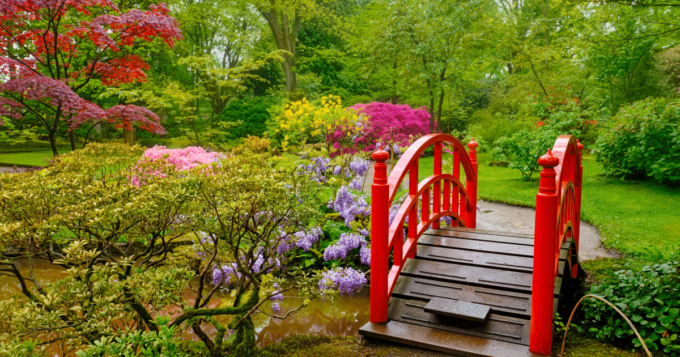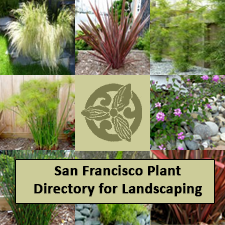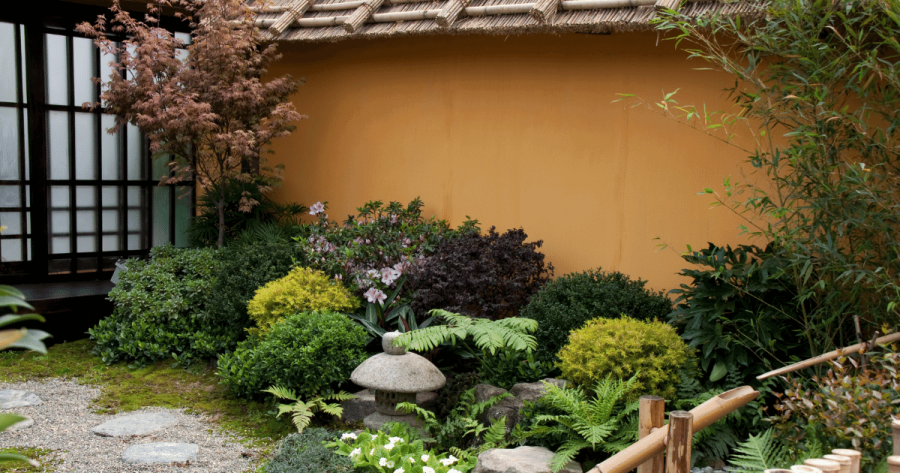
It’s no surprise that a Japanese garden offers balance, beauty, aesthetics and a serene oasis, that not only make it an ideal choice for your outdoor space, but also a highly sought after garden type. The question to ask, is this tranquil retreat – your Zen garden – difficult to create? What gives a garden its very noticeable authentic Asian flair?
Creating a peaceful retreat in your own backyard is easier than you might think. The right elements – large stones, rocks and pebbles, water features, right lighting or example – are a few things you need to add that touch of Zen to your outdoor space.
Here are a few essential elements that will help you achieve the perfect serene oasis:
Rocks and Gravel
Rocks and stones are used to symbolize natural phenomena, such as mountains or the sea. These elements can help create a connection between the garden and nature.
Traditional Japanese style gardens often have multiple layers of gravel and rock. These layers create pathways through the garden, leading you from from focal point to focal point. For example, you can use larger stones of various shapes and sizes on a bed of carefully raked gravel as a focal point.
Choosing the Right Stones for Your Japanese Garden
Each focal point of a Japanese garden is a scene, carefully designed and brought to life. This is done by using a variety of stones and rocks that each bring their own meaning or symbolism to a garden. For example:
- Large stones can represent mountains, whereas smaller pebbles represent the sea.
- Sandstone is often used to create pathways and represents journeys, while granite symbolizes strength.
- River rock can be used to create streams and waterfalls, a reminder of the natural world.
- Even moss-covered stones are often included in these gardens, representing age and wisdom.
With careful selection, you can make sure your oasis is full of meaning and beauty.
Water Elements
Water features, such as koi ponds, streams and waterfalls, represent the movement of life force energy within the garden. These elements provide added beauty to your eyes, as well as a soft, calming sound to your ears.
The sound of trickling water provides peace and relaxation, which is why water elements like ponds, fountains, streams and waterfalls are essential in Japanese gardens. Placing these features strategically allows the flowing water to direct visitors through your garden landscape.
Which Water Elements Should You Choose?
When choosing water elements for your Japanese Zen garden, there are several key points to consider:
- Size – The size of the water feature should depend on the size and layout of your garden. Will a waterfall fit in your space? If you want Koi, how big a pond will you need? Although a big Koi pond or waterfall is beautiful, sometimes the best water feature might be something like a shishi-odohi – a type of water fountain
- Placement – Consider where you’re going to put your water element. Fountains near walkways can create a beautiful focal point while ponds tucked away in corners can create private retreats.
- Maintenance – Some water features, such as waterfalls and ponds, require more maintenance than others. Be sure to ask your landscaper how much it takes to maintain before you choose one.
Plants and Flowers
Japanese gardens often feature large trees or clusters of smaller shrubs to provide shade and texture variation. Colorful flowers have their own symbolism in Japan, and add to the visual beauty of your garden.
A wide variety of plants can be used in order to bring different textures, shapes and colors into your space. However, Japanese gardens are very much about balance. Your plants should be carefully placed to ensure they create harmony and continue that sense of balance.
Bamboo is a classic choice for its ability to thrive in small spaces without getting too unruly when properly pruned back regularly. However there are plenty of other options, including maple trees, iris flowers and bonsai shrubs – all of which provide beautiful visual appeal indoors or out.
Best Plants, Flowers and Trees for a Japanese Garden in San Francisco
It’s easy to look at Japanese gardens on Pinterest, fall in love with a tree or plant, and decide those are the ones you want in your garden. -But San Francisco has its own biomes and climate, and you want to make sure you give your garden the best chance at thriving.
When designing a Japanese garden in San Francisco, it is important to choose plants and trees that are suitable for the climate. Some of the best choices for this area include:
- Trees: Japanese Red Maple, Katsura, Trident Maple, Weeping Cherry, Japanese Umbrella Pine
- Flowers: Fraser’s Photinia
- Ground cover: Mondo Grass
- Grasses: Blue Fescue, Mexican Feather Grass
Garden Ornaments
Accentuating areas with stone lanterns, pagodas or even koi art pieces brings a heightened sense of movement within your garden while also inspiring feelings of wonderment.They can also be used to mark paths, divide spaces, draw attention to focal points, and indicate destinations.
Garden ornaments have been used in traditional Japanese gardens for centuries. From lanterns to stone pagodas and more, they come in a variety of shapes, sizes and materials. Often, they have a symbolic meaning. For example, cranes represent longevity, turtles represent health, and koi fish represent good luck.
What to Know About Placing Garden Ornaments in a Japanese Garden
The more traditional you want your serene oasis to be, the more important the placement of garden ornaments is. Careful thought should be put into where a particular ornament is placed as it can help create balance and harmony.
- Consider how the ornament fits into the overall flow of the landscape. The best placement for an ornament is one that adds balance and enhances the atmosphere of the space.
- Determine what type of statement you want the ornament to make. Different ornaments convey different meanings, so think about what message or feeling you want it to invoke and choose accordingly.
- Place larger ornaments toward the back of your garden, while smaller ones should be kept closer to the front. This helps create depth and interest in your design. This is especially true in places like San Francisco, when your space may only be a thin strip rather than a large back yard.
- Put thought into where pathways and walkways lead, as well as focal points within your garden. A special ornament placed along these paths can help draw attention and indicate purpose and direction.
Conclusion
If your outdoor space is large, it’s easy to dream about what you want there. The smaller your space, you may start to think there’s not enough room to create the Japanese garden you want. However, even a few, well-thought-out and well-placed accents can make a huge difference.
Creating a peaceful refuge doesn’t have to require an immense amount of effort or large expanses of land — using these four essentials will give you all the necessary tools needed for crafting an enchanting Japanese garden escape right in your own backyard!



